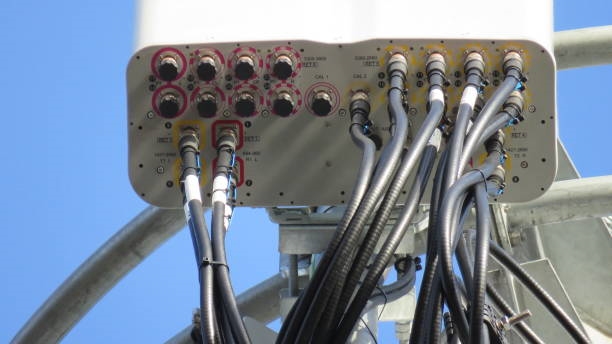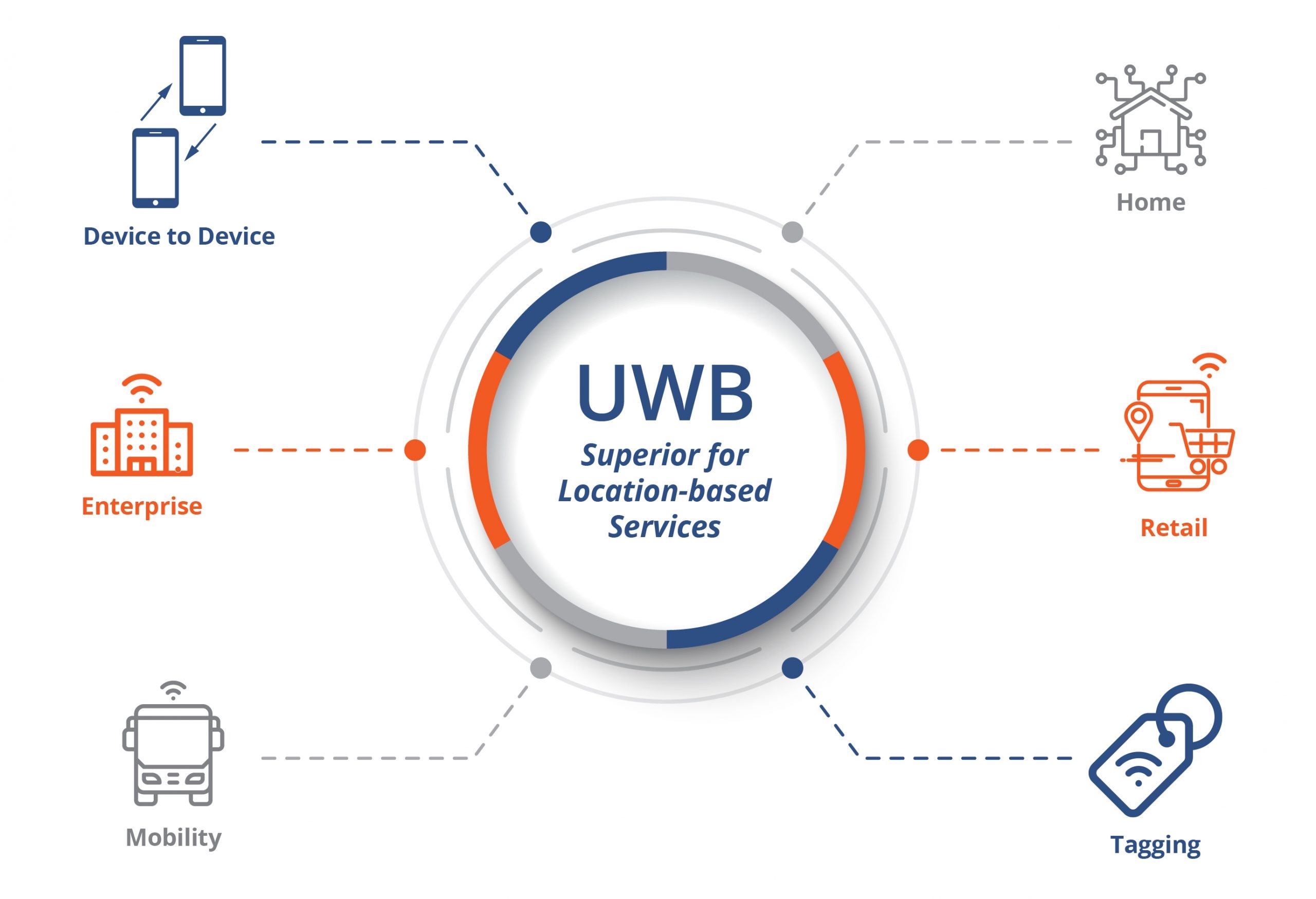Suffix meaning recap
None Single Carrier
A Carrier Aggregation (CA)
B Dual-Connectivity (DC)
C Supplement Uplink (SUL)
D UL MIMO
E V2X
F Shared spectrum channel access
G Tx Diversity (TxD)
I RedCap
Chapters labeled with 6.5 previously covered single carrier spectrum emissions. By the above convention, 6.5A refers to the CA portion of spectrum emissions. Before studying CA spectrum emissions, the CA-supported bands, component carrier combinations, and CA bandwidth definitions must be clarified.
CA band combinations
To date, 3GPP defines 53 FR1 bands from n1 to n101. The listings below show uplink (UL) first and downlink (DL) second.
n1 1920 MHz - 1980 MHz 2110 MHz - 2170 MHz FDD
n2 1850 MHz - 1910 MHz 1930 MHz - 1990 MHz FDD
n3 1710 MHz - 1785 MHz 1805 MHz - 1880 MHz FDD
n5 824 MHz - 849 MHz 869 MHz - 894 MHz FDD
n7 2500 MHz - 2570 MHz 2620 MHz - 2690 MHz FDD
n8 880 MHz - 915 MHz 925 MHz - 960 MHz FDD
n12 699 MHz - 716 MHz 729 MHz - 746 MHz FDD
n13 777 MHz - 787 MHz 746 MHz - 756 MHz FDD
n14 788 MHz - 798 MHz 758 MHz - 768 MHz FDD
n20 832 MHz - 862 MHz 791 MHz - 821 MHz FDD
n24 1626.5 MHz - 1660.5 MHz 1525 MHz - 1559 MHz FDD
n25 1850 MHz - 1915 MHz 1930 MHz - 1995 MHz FDD
n26 814 MHz - 849 MHz 859 MHz - 894 MHz FDD
n28 703 MHz - 748 MHz 758 MHz - 803 MHz FDD
n29 N/A 717 MHz - 728 MHz SDL
n30 2305 MHz - 2315 MHz 2350 MHz - 2360 MHz FDD
n34 2010 MHz - 2025 MHz 2010 MHz - 2025 MHz TDD
n38 2570 MHz - 2620 MHz 2570 MHz - 2620 MHz TDD
n39 1880 MHz - 1920 MHz 1880 MHz - 1920 MHz TDD
n40 2300 MHz - 2400 MHz 2300 MHz - 2400 MHz TDD
n41 2496 MHz - 2690 MHz 2496 MHz - 2690 MHz TDD
n46 5150 MHz - 5925 MHz 5150 MHz - 5925 MHz TDD
n47 5855 MHz - 5925 MHz 5855 MHz - 5925 MHz TDD
n48 3550 MHz - 3700 MHz 3550 MHz - 3700 MHz TDD
n50 1432 MHz - 1517 MHz 1432 MHz - 1517 MHz TDD
n51 1427 MHz - 1432 MHz 1427 MHz - 1432 MHz TDD
n53 2483.5 MHz - 2495 MHz 2483.5 MHz - 2495 MHz TDD
n65 1920 MHz - 2010 MHz 2110 MHz - 2200 MHz FDD
n66 1710 MHz - 1780 MHz 2110 MHz - 2200 MHz FDD
n70 1695 MHz - 1710 MHz 1995 MHz - 2020 MHz FDD
n71 663 MHz - 698 MHz 617 MHz - 652 MHz FDD
n74 1427 MHz - 1470 MHz 1475 MHz - 1518 MHz FDD
n75 N/A 1432 MHz - 1517 MHz SDL
n76 N/A 1427 MHz - 1432 MHz SDL
n77 3300 MHz - 4200 MHz 3300 MHz - 4200 MHz TDD
n78 3300 MHz - 3800 MHz 3300 MHz - 3800 MHz TDD
n79 4400 MHz - 5000 MHz 4400 MHz - 5000 MHz TDD
n80 1710 MHz - 1785 MHz N/A SUL
n81 880 MHz - 915 MHz N/A SUL
n82 832 MHz - 862 MHz N/A SUL
n83 703 MHz - 748 MHz N/A SUL
n84 1920 MHz - 1980 MHz N/A SUL
n86 1710 MHz - 1780 MHz N/A SUL
n91 832 MHz - 862 MHz 1427 MHz - 1432 MHz FDD
n92 832 MHz - 862 MHz 1432 MHz - 1517 MHz FDD
n93 880 MHz - 915 MHz 1427 MHz - 1432 MHz FDD
n94 880 MHz - 915 MHz 1432 MHz - 1517 MHz FDD
n95 2010 MHz - 2025 MHz N/A SUL
n96 5925 MHz - 7125 MHz 5925 MHz - 7125 MHz TDD
n97 2300 MHz - 2400 MHz N/A SUL
n99 1626.5 MHz - 1660.5 MHz N/A SUL
n100 874.4 MHz - 880 MHz 919.4 MHz - 925 MHz FDD
n101 1900 MHz - 1910 MHz 1900 MHz - 1910 MHz TDD
How are FR1 CA bands and their combinations defined? CA is classified three ways:
- Intra-band contiguous carrier aggregation: CA configuration is a single operating band that supports an NR CA bandwidth class.
- Intra-band non-contiguous CA: CA configuration is a single operating band that supports two or more sub-blocks, each sub-block supporting an NR CA bandwidth class.
- Inter-band CA: CA configuration is a combination of operating bands; each band supports an NR CA bandwidth class.
1. Intra-band contiguous CA: the following are available:
CA_n40
CA_n41
CA_n46
CA_n48
CA_n66
CA_n77
CA_n78
CA_n79
Within these, multiple specific combinations exist. The table below selects the Chinese market bands n41, n78 and n79 for examples of intra-band contiguous CA and their maximum aggregated bandwidths. Note that downlink CA and uplink CA configurations can differ. CA requires more than one aggregated carrier, but CA may be applied only in the downlink while uplink remains single carrier, or both uplink and downlink may support CA with identical or different configurations.
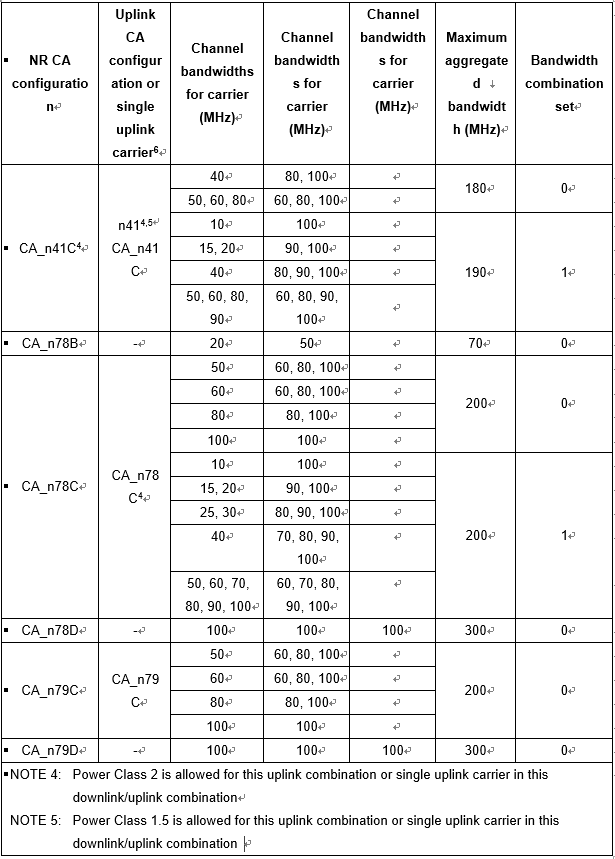
In that table, suffixes like B, C, D after a band (for example n78D) represent NR CA bandwidth classes. For instance, class D indicates bandwidth greater than 200 MHz and less than or equal to 3 × BWChannel,max. A detailed definition of CA bandwidth classes appears below.
2. Intra-band non-contiguous CA: the following are available:
CA_n2
CA_n48
CA_n66
CA_n71
CA_n77
CA_n78
Multiple specific combinations exist; see the table below. Note that for intra-band non-contiguous CA, only n77 currently has an uplink CA configuration; other bands do not yet define UL CA. The annotations (2A) and (3A) indicate two or three non-contiguous carriers respectively.
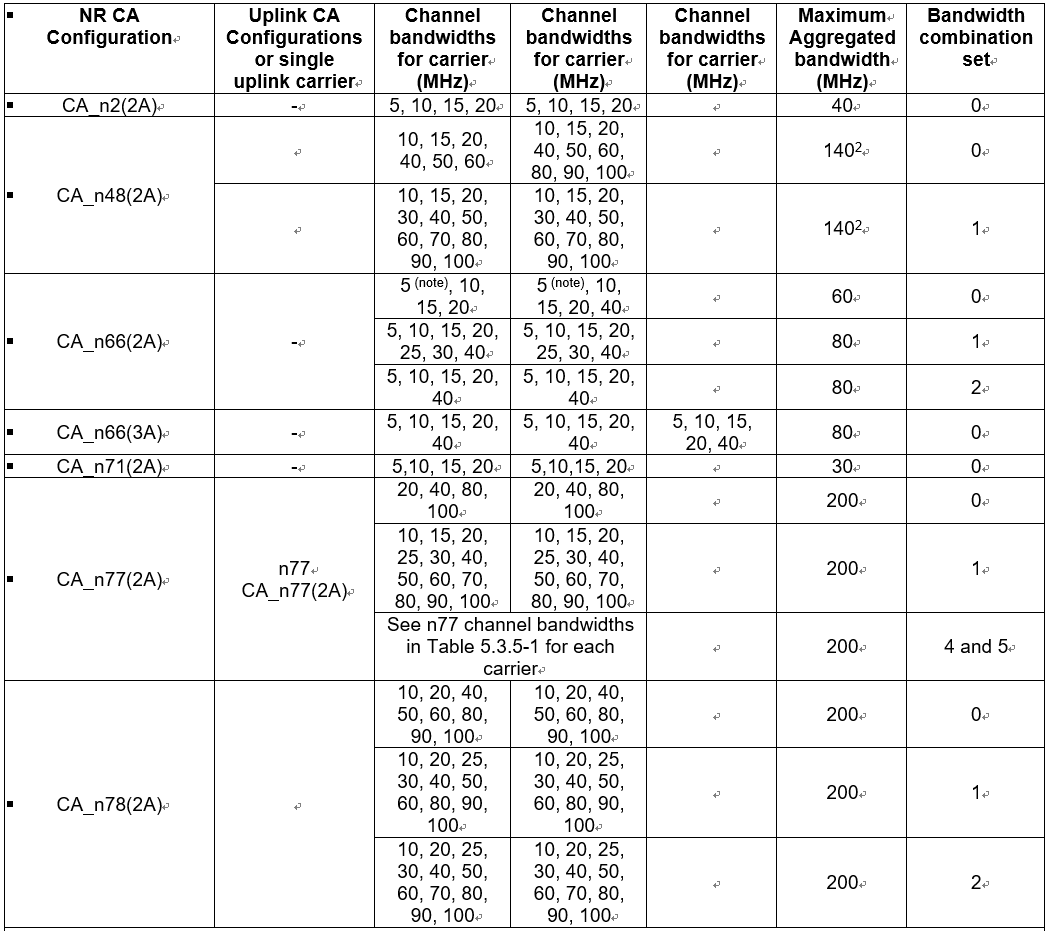
3. Inter-band CA is defined for combinations of 2, 3, and 4 bands.
Two-band combinations are defined as follows. Most inter-band dual-carrier CA pairs pair a low band (700 MHz - 3 GHz) carrier with a mid band (3 - 5 GHz) carrier, though some pairs use two mid-band carriers (for example n78-n79).
CA_n1-n3
CA_n1-n8
CA_n1-n28
CA_n1-n77
CA_n1-n78
CA_n2-n5
CA_n2-n14
CA_n2-n48
CA_n2-n66
CA_n2-n77
CA_n3-n5
CA_n3-n8
CA_n3-n28
CA_n3-n41
CA_n3-n77
CA_n3-n78
CA_n5-n7
CA_n5-n48
CA_n5-n66
CA_n5-n77
CA_n5-n78
CA_n7-n78
CA_n8-n78
CA_n14-n30
CA_n14-n66
CA_n14-n77
CA_n20-n78
CA_n24-n41
CA_n24-n48
CA_n24-n77
CA_n25-n66
CA_n25-n77
CA_n25-n78
CA_n25-n46
CA_n26-n66
CA_n26-n70
CA_n28-n41
CA_n28-n77
CA_n28-n78
CA_n28-n79
CA_n29-n66
CA_n29-n70
CA_n29-n71
CA_n39-n41
CA_n41-n66
CA_n41-n71
CA_n41-n79
CA_n46-n48
CA_n46-n66
CA_n48-n66
CA_n48-n70
CA_n48-n71
CA_n48-n77
CA_n66-n70
CA_n66-n71
CA_n66-n77
CA_n66-n78
CA_n70-n71
CA_n71-n77
CA_n77-n79
CA_n78-n79
As an example of a configuration with CA in both uplink and downlink, consider n1-n78:

Three-band CA combinations and examples:
CA_n1-n3-n28
CA_n1-n3-n78
CA_n1-n78-n79
CA_n2-n5-n48
CA_n2-n5-n77
CA_n2-n48-n66
CA_n2-n48-n77
CA_n2-n66-n77
CA_n3-n28-n41
CA_n3-n28-n77
CA_n3-n28-n78
CA_n5-n48-n66
CA_n5-n48-n77
CA_n5-n66-n77
CA_n25-n66-n77
CA_n25-n66-n78
CA_n26-n66-n70
CA_n28-n41-n79
CA_n29-n66-n70
CA_n41-n66-n71
CA_n48-n66-n70
CA_n48-n66-n71
CA_n48-n66-n77
CA_n48-n70-n71
CA_n66-n70-n71
Four-band CA combinations and examples:
CA_n1-n3-n28-n78
CA_n2-n5-n48-n66
CA_n2-n5-n48-n77
CA_n2-n5-n66-n77
CA_n2-n48-n66-n77
CA_n5-n48-n66-n77
How CA bandwidth is calculated
First, for the maximum transmission bandwidth configuration, intra-band contiguous and intra-band non-contiguous CA follow the same requirements as single carrier; for inter-band CA, each component carrier's bandwidth must be assessed separately, and each component carrier follows the same single-carrier requirements.
Second, the calculation of the actual occupied CA bandwidth is as follows:
- Intra-band contiguous CA: as shown below, the aggregated channel bandwidth BWChannel_CA is defined as BWChannel_CA = Fedge,high - Fedge,low (MHz). Since carriers are contiguous, the aggregated bandwidth equals the highest edge minus the lowest edge.
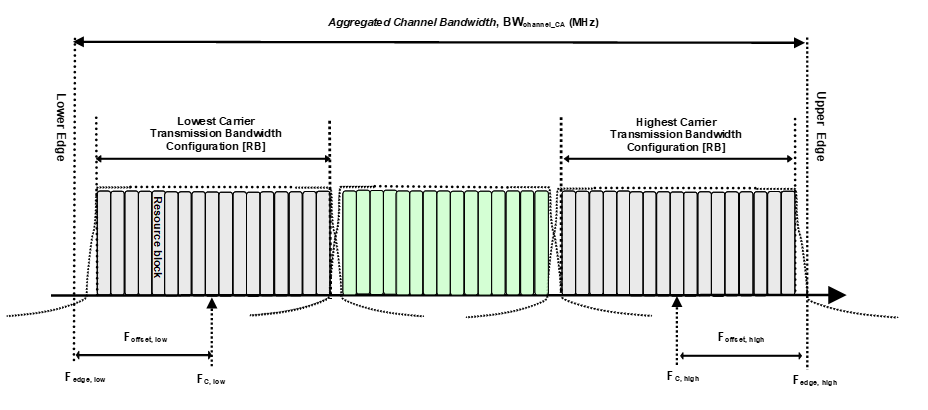
- Intra-band non-contiguous CA: as shown below, because carriers are non-contiguous, the bandwidth of each contiguous sub-block must be considered. Each sub-block's bandwidth is calculated the same way as for contiguous CA.
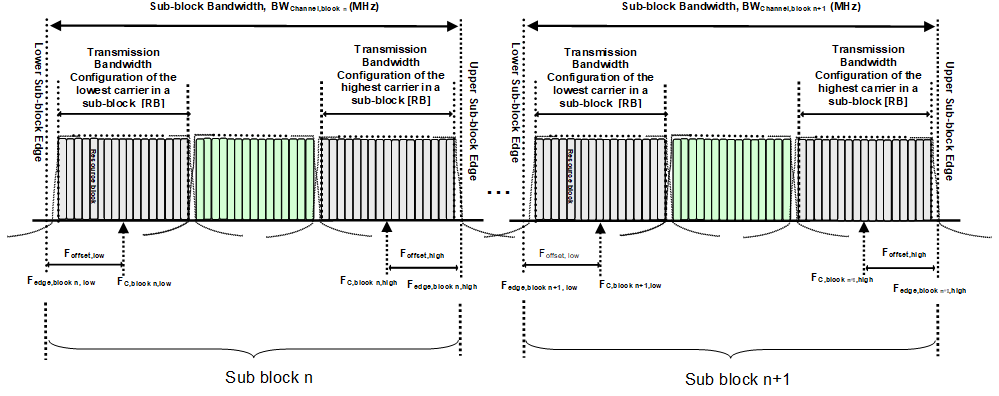
For intra-band non-contiguous CA, a frequency separation class Fs is defined to indicate, when dual-PA architecture IE signaling is absent, the maximum frequency span between the lowest edge of the lowest component carrier and the highest edge of the highest component carrier that can be supported for each band combination in UL non-contiguous intra-band operation.
The table below defines a single operating band supporting two or more sub-blocks for intra-band non-contiguous CA. Each sub-block supports an NR CA bandwidth class. Different bandwidth classes correspond to parameters: aggregated bandwidth, number of contiguous carriers, and fallback group (UE must be able to fall back to lower NR CA bandwidth class configurations within the same fallback group, but is not required to fall back to configurations in different fallback groups).
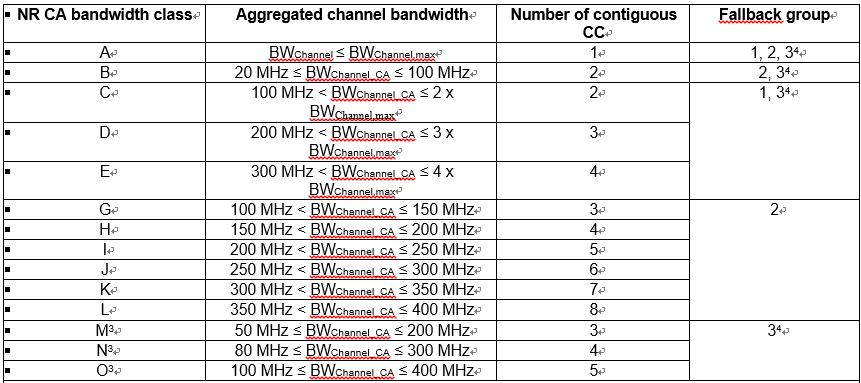
3. For inter-band CA, the CA configuration is a combination of multiple operating bands; each band supports one of the NR CA bandwidth classes shown above.
 ALLPCB
ALLPCB


